2018 highlights
We at Aspen Journalism, which was founded in January 2011, have successfully completed our eighth full year of operations.
In 2018, we published 74 in-depth stories, 70 of them about water issues in the Colorado River basin, which includes the Roaring Fork River basin.
To inform our reporting, we attended 54 water meetings and events around Colorado.
We collaborated on our water stories with The Aspen Times, the Glenwood Springs Post Independent, the Vail Daily, the Summit Daily, the Steamboat Pilot and the Greeley Tribune.
And we produced sustained and impactful reporting on potential dams on Maroon Creek and Castle Creek tied to conditional water-storage reservoir rights.
And we continued in-depth coverage of key Colorado River issues, including statewide and regional response to ongoing severe drought conditions.
Aspen Journalism was supported by over 100 donors who contributed just over $200,000 toward our efforts in 2018.
We believe our donors support us because they value facts and the truth and are hoping for a future that includes a vigorous free press and a vital democracy.
So we honor them by working hard to turn their well-founded hope into well-grounded truth, because well-informed citizens make better decisions.
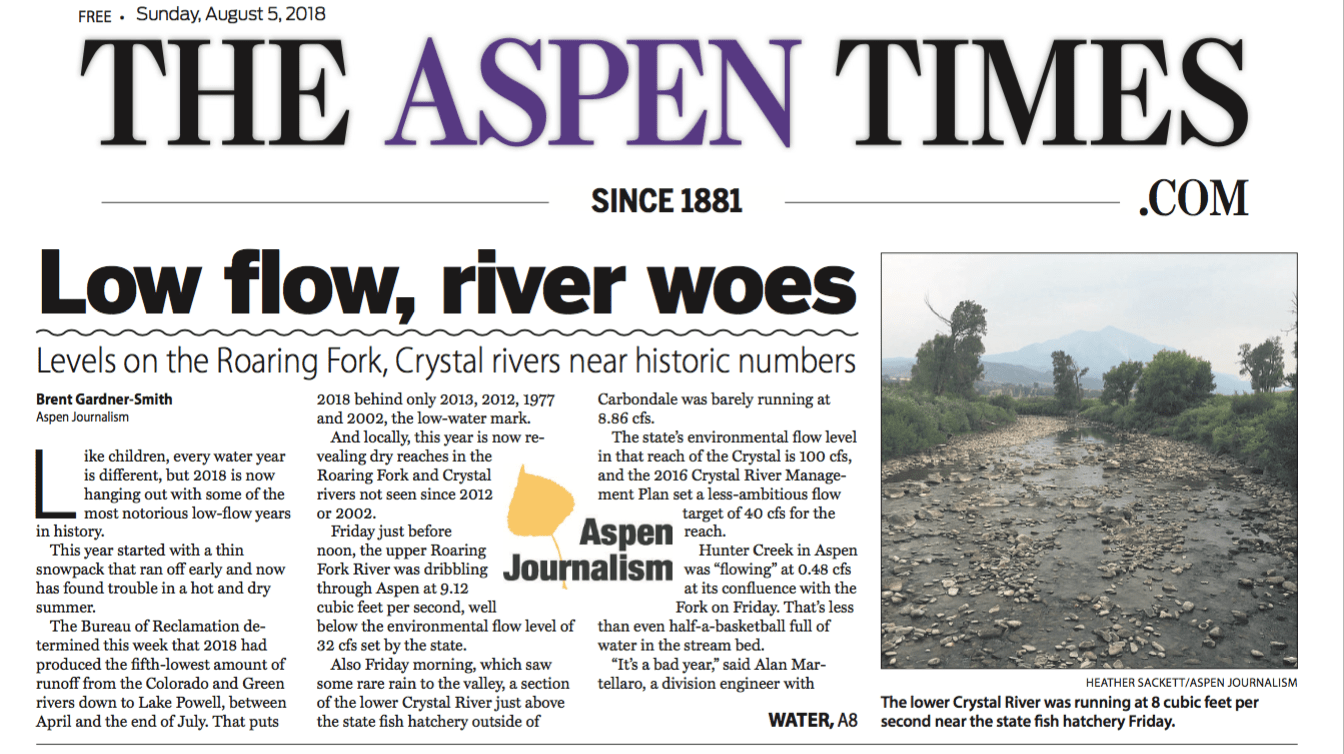
Evaluating Aspen Journalism
In our annual reports, we attempt to measure and review our performance. We look at our:
financial capacity (revenue from donations: $200,000 in 2018);
reporting capacity (number of reporters and editors we deployed: 1.5 full-time equivalents);
our approach to reporting (investigative, collaborative, beat- and document-driven, freelance-assisted);
our newsgathering efforts (attending a lot of water meetings, visiting a lot of physical locations);
our productivity (how many stories we produced: 74 in 2018, including 70 on water and rivers);
our reach (how many people may have read our work: potentially about 10,000 people per story, or 740,000).
our impact (what we may have changed or influenced: city of Aspen’s decisions on water rights, awareness of looming potential water-use cuts);
the response to our work (based on unsolicited feedback: pretty good).
Details below!

Financial capacity
Revenue in 2018: $204,000
Expenses in 2018: $202,000
Reporting capacity
In 2018 we had one full-time editor/reporter, who also served as photographer and website manager.
We also worked with six freelance reporters and one freelance copy editor. Our expenditures on freelance reporting and editing totaled about $50,000.
Our approach to reporting
Aspen Journalism in 2018 staffed one primary desk — the “water desk.” Brent Gardner-Smith served as the reporter, editor and photographer for the desk, covering rivers and water in the Roaring Fork and Colorado river basins.
Also in 2018, freelance reporters Heather Sackett, Lindsay Fendt and Sarah Tory wrote stories about water and rivers for Aspen Journalism.
Our stories on water were published — via our ongoing collaboration with the newspapers of Swift Communications — in The Aspen Times, the Glenwood Springs Post Independent, the Vail Daily, the Summit Daily, the Steamboat Pilot and the Greeley Tribune.
We also began a collaboration with The Colorado Sun and its reporter Jason Blevins, who is covering regional mountain biking and recreation trails, including the potential trail from Carbondale to Crested Butte. Jason wrote two stories for us about the trail, and they appeared in The Aspen Times and The Colorado Sun.
We asked freelance writer and reporter Ali Margo to collaborate with Aspen Sojourner and write about what it is like working as an undocumented worker in Aspen’s resort economy during the Trump administration.
And Tim Cooney, a local freelance writer, wrote an in-depth piece, in collaboration with the Aspen Daily News, on the fatal 1984 avalanche in Highland Bowl. The article, which included historical photos, was also published in The Avalanche Review, the journal of the American Avalanche Association.
Newsgathering efforts
We informed our reporting by defining a beat and then attending informative meetings relevant to the beat. We also visited the locations of a long list of water projects and, yes, rivers, the source of the majority of water used by Aspenites and the other residents of Colorado.
As an example — and to serve as future documentation — below is a list of the 54 water meetings, seminars, and tours and conference calls that reporters for Aspen Journalism attended in 2018. Unless otherwise noted, the events were attended by Brent Gardner-Smith.

2018 Water meetings and events attended by Aspen Journalism reporters
Colorado River District, Glenwood Springs, Jan. 16 and 17
Colorado River Basin Roundtable, Glenwood Springs, Jan. 22
Colorado Water Congress, Denver, Jan. 24-26
Colorado River Basin Roundtable, Next Steps, Glenwood Springs, Feb. 26
Division 5 Water Court, Powderhorn case, Glenwood Springs, March 7 and 8
Pitkin County Healthy Rivers and Streams, Basalt, March 15
Colorado Water Conservation Board, Broomfield, via YouTube, March 21 and 22
Colorado River Basin Roundtable, Glenwood Springs, March 26
Rio Grande River Basin Roundtable, Alamosa, April 10
Southwest Basin Roundtable, Durango, April 11
Colorado River Basin Roundtable, Next Steps, via phone, April 23
Four Western Slope Basin Roundtables, Grand Junction, April 25

Water in the West Symposium, Denver, April 26 and 27
Interbasin Compact Committee, Keystone, May 2
Colorado Water Conservation Board, Salida, May 23 and 24 (Heather Sackett)
Friends of the Yampa and American Rivers, Yampa River, May 24-29
Colorado River District, state of the Roaring Fork, Carbondale, May 31 (Brent Gardner-Smith and Heather Sackett)
Getches-Wilkinson Center seminar, University of Colorado at Boulder Law School, June 7 and 8
Front Range Roundtables, Parker, June 13 (Brent Gardner-Smith and Lindsay Fendt)
State of Colorado Water Availability task force, June 14 (Lindsay Fendt)
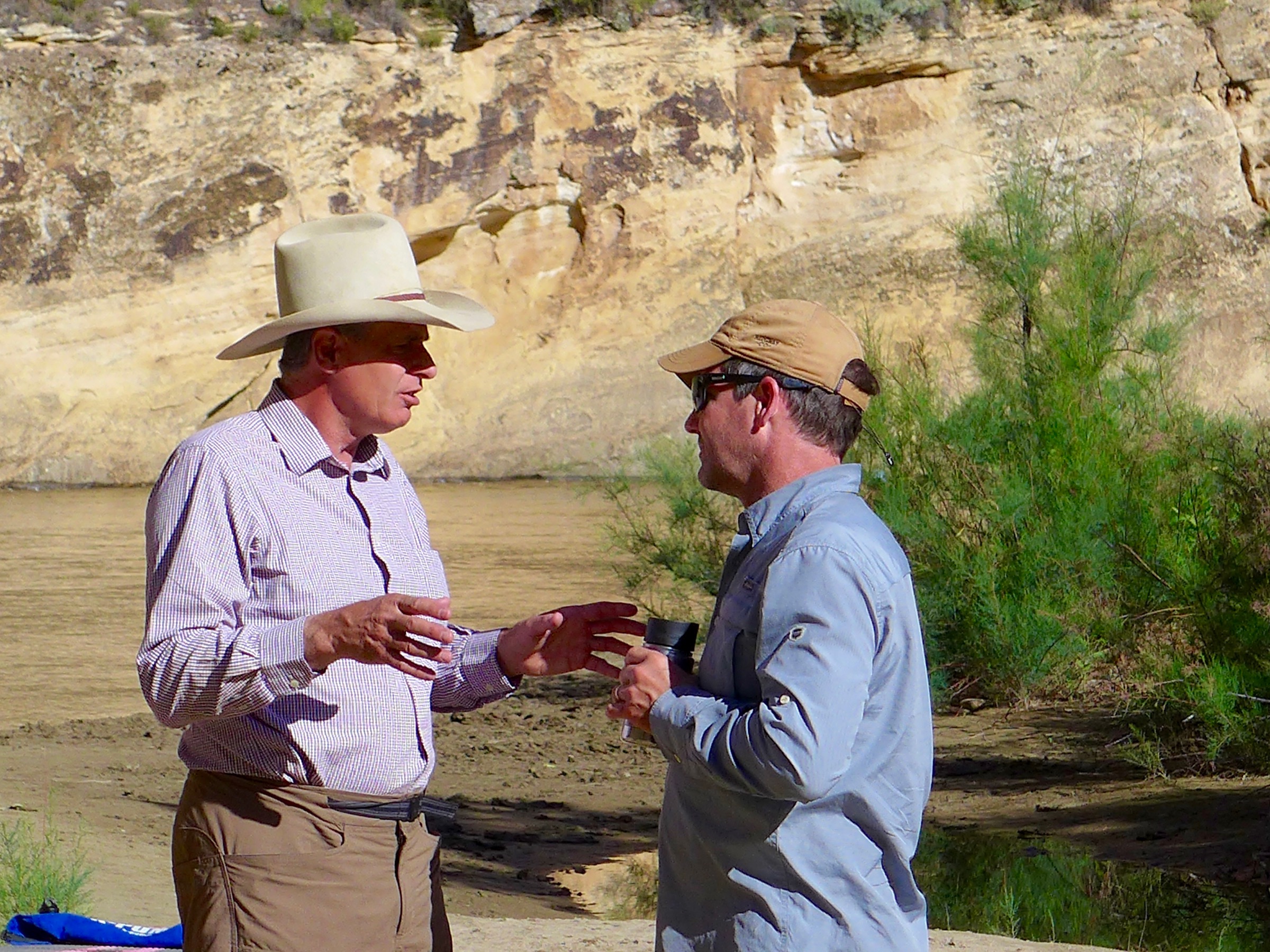
Integrated Water Management Planning conference call, June 19 (Heather Sackett)
Upper Colorado River Commission, Santa Fe, June 20
Pitkin County Health Rivers and Streams, Basalt, June 21 (Heather Sackett)
Colorado River Basin Roundtable, Next Steps, Glenwood Springs, June 25
South Platte Regional Working Group, Denver, June 25 (Lindsay Fendt)
South Platte Regional Working Group, Longmont, June 9 (Lindsay Fendt)
South Platte Roundtable, Longmont, July 10 (Lindsay Fendt)
Metro Roundtable, Denver, July 12 (Lindsay Fendt)
Gunnison Roundtable, Montrose, July 16 B
Colorado River District meeting, Glenwood Springs, July 17 and 18

Colorado Water Conservation Board, Glenwood Springs, July 18 and 19 (Brent Gardner-Smith and Heather Sackett)
Pitkin County Healthy Rivers and Streams, Basalt, July 19
Colorado Basin Roundtable, Glenwood Springs, July 23
White River dam location tour, Rangely, Aug. 6
Arkansas River Basin Roundtable, Pueblo, Aug. 8
Northern Water board meeting, Berthoud, Aug. 9
Bureau of Reclamation and Ruedi meeting, Basalt, Aug. 9
Roaring Fork Conservancy River Center opening, Basalt, Aug. 10
Historic Users Pool conference call, Aug. 15
Southeastern Water Conservancy District, Pueblo, Aug. 16
Colorado Water Congress, Vail, Aug. 22
Colorado River District webinar, Aug. 29
Yampa/White/Green Basin Roundtable, Rangely, Sept. 12
Rio Blanco Water Conservancy District, tour of dam site, Rangely, Sept. 12
Colorado River District seminar, Grand Junction, Sept. 14
Colorado Water Conservation Board, Steamboat, via internet, Sept. 19 and 20

Colorado River District, Glenwood Springs, Oct. 16 and 17
Grand Valley Water Users Association, Grand Junction, Oct. 23
Colorado River Basin Roundtable, Next Steps, Glenwood Springs, Oct. 29
Colorado Water Conservation Board, Golden, Nov. 14 and 15
Colorado River Basin Roundtable, Glenwood Springs, Nov. 26
Colorado River District board meeting, Glenwood Springs, Nov. 26
Ruedi Water and Power Authority, Basalt, Nov. 29
Colorado River Water Users Association, Las Vegas, Dec. 12-14
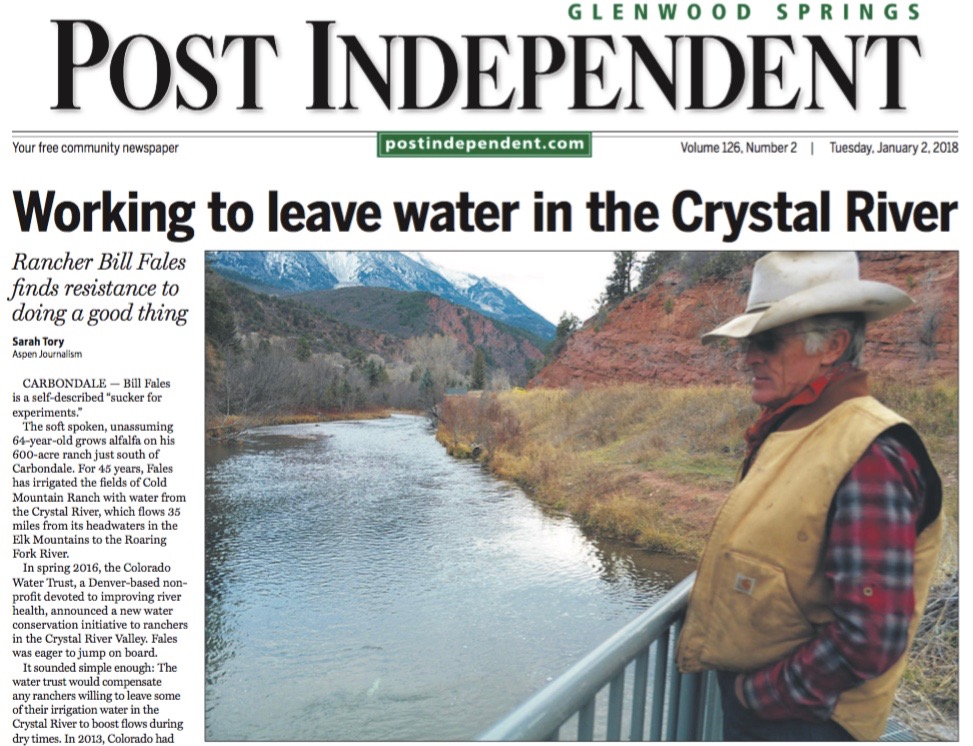
Story Production
Aspen Journalism reporters covering water and rivers wrote a total of 70 water stories in 2018. Gardner-Smith wrote 47 of them, a number consistent with prior years, while Sackett wrote 14, Fendt wrote seven and Tory wrote two.
Of those water stories, 45 were published in The Aspen Times, 20 in the Post Independent, 10 in the Vail Daily, four in the Summit Daily, three in the Greeley Tribune and one in the Steamboat Pilot. Some stories appeared in more than one newspaper. Most were done in direct collaboration with the editor of The Aspen Times.
Of the four non-water stories we published, one was with the Aspen Daily News (Highland Bowl avalanche), one with Aspen Sojourner magazine (Aspen labor force), one with The Colorado Sun (Crystal River valley trail) and one with The Aspen Times (Crystal River valley trail).
All of our stories were also published on the Aspen Journalism website under a Creative Commons license, which allows any other publication or website to publish them under certain rules and guidelines.
Additionally, almost all of our water stories were published on Coyote Gulch, a digital aggregation of water stories on Colorado River water issues.
Most of our stories gained further exposure through a daily email list of state and regional water stories prepared by Loretta Lohrman, as well as other emailed, aggregated water-story roundups such as BC Water News, which is Brown and Caldwell’s daily newsletter.

2018 story list: water
(Note: The dates below are the dates of publication on Aspen Journalism’s website, which can differ from the dates when collaborating newsrooms published their version of the stories.)
Jan. 2, 2018
Aspen officials say city needs to store 8,500 acre-feet of water as backup
By Brent Gardner-Smith
Jan. 2, 2018
Rancher trying to leave water in the Crystal River stalled by Pitkin County
By Sarah Tory
Jan. 4, 2018
Study provides insight into how dams affect ecology of southwestern Colorado rivers
By Heather Sackett
Jan. 5, 2018
Aspen’s proposal to move rights out of Castle and Maroon creeks well-
received
By Brent Gardner-Smith
Jan. 19, 2018
Drought-response preparations becoming more ‘routine’ for Eagle River Basin
By Heather Sackett
Jan. 24, 2018
Rancher on Crystal River agrees to change diversions to benefit river
By Sarah Tory
Feb. 14, 2018
City of Aspen to adjust its water-efficient landscaping regulations
By Brent Gardner-Smith
Feb. 21, 2018
Pitkin County embraces reuse of household graywater
By Brent Gardner-Smith

March 2, 2018
Aspen pays $2.68M for land in Woody Creek to use for potential reservoirs
By Brent Gardner-Smith
March 25, 2018
Snow and tell: Low snow-water levels in Roaring Fork basin indicate poor runoff
By Heather Sackett
March 27, 2018
Public funds used for irrigation study in Eagle County, but privacy maintained
By Heather Sackett

By April 3, 2018
Low runoff into Colorado River could be hard on endangered fish
By Brent Gardner-Smith
By April 4, 2018
Colorado mining bill aims to protect water quality near mining operations
By Heather Sackett
April 9, 2018
State grants flowing into Colorado, Roaring Fork and Eagle rivers
By Heather Sackett
April 13, 2018
Colorado snowpack thin in south; Colorado River basin at 86 percent
By Brent Gardner-Smith
April 26, 2018
Colorado water managers studying Lake Powell levels and issues
By Brent Gardner-Smith
April 30, 2018
Water experts talk drier Colorado at new Colorado State forum
By Brent Gardner-Smith

May 1, 2018
Timeline: tracking the proposed White River dam and reservoir
By Brent Gardner-Smith
May 7, 2018
Wringing what’s left out of the booming South Platte River basin
By Brent Gardner-Smith
By May 9, 2018
Aspen moves closer to settling Castle and Maroon dam cases
By Brent Gardner-Smith
May 14, 2018
Homing in on options for a potential White River Dam near Rangely
By Brent Gardner-Smith
May 24, 2018
City of Aspen reaches agreement with five parties on moving Maroon and Castle creek water rights
By Brent Gardner-Smith

June 2, 2018
Court battle continues over Windy Gap firming project
By Lindsay Fendt
June 7, 2018
Shoshone plant water rights in Glenwood Canyon eyed by Colorado River District
By Heather Sackett
June 7, 2018
Fryingpan River proposal would increase winter flows, help trout populations
By Brent Gardner-Smith
June 12, 2018
Pitkin County close to securing 1,000 acre-freet of water for upper Roaring Fork
By Brent Gardner-Smith
June 16, 2018
Town of Carbondale’s Weaver Ditch focus of study on water efficiency
By Heather Sackett
June 22, 2018
Upper Colorado River pilot program paying irrigators to leave water for Lake Powell will end after 2018
By Brent Gardner-Smith
June 24, 2018
Drought conditions in Colorado continue to be dire in latest update
By Lindsay Fendt
June 28, 2018
City of Aspen moves closer to settlements on Castle and Maroon creeks water-rights cases
By Brent Gardner-Smith
June 28, 2018
Senior calls on the river, fish water in the Pan
By Heather Sackett
June 29, 2018
Officials release Upper Roaring Fork Management Plan
By Heather Sackett

July 4, 2018
Aspen signs deals with American Rivers, Trout Unlimited to move Castle/Maroon dam rights
By Brent Gardner-Smith
July 10, 2018
Eagle River water-efficiency plan focuses on reducing outdoor residential waste
By Heather Sackett
July 20, 2018
State water board OKs leases for Ruedi Reservoir releases to help endangered fish
By Heather Sackett
July 22, 2018
Front Range water providers to seek state funds to study storage project
By Lindsay Fendt
July 23, 2018
Colorado’s water managers decry lack of water, surplus of fire
By Brent Gardner-Smith
July 27, 2018
Western Slope to keep studying water without state funds, Front Range support
By Brent Gardner-Smith

August 6, 2018
Low flows on the Crystal River lead to state action
Heather Sackett
August 6, 2018
As a water year, 2018 is in bad company
By Brent Gardner-Smith
August 17, 2018
PitCo river board comments on proposed Crystal Valley trail
Heather Sackett
August 18, 2018
USFS opposes Fry-Ark conditional water rights in Holy Cross Wilderness
By Brent Gardner-Smith
Aug. 22, 2018
Northern Water, citing lawsuit, delays bonds for big dam tied to Windy Gap
By Brent Gardner-Smith
Aug. 22, 2018
Aspen settles Castle Creek Reservoir case, closes in on Maroon case
By Brent Gardner-Smith
Aug. 25, 2018
Colorado water officials stepping up ‘demand management’ efforts
By Brent Gardner-Smith
Aug. 27, 2018
Candidates share views on water storage at Colorado Water Congress
By Brent Gardner-Smith

Sept. 17, 2018
Economic feasibility of White River off-channel dam and reservoir questioned
By Brent Gardner-Smith
Sept. 17, 2018
Regional water managers facing up to impacts of climate change
By Brent Gardner-Smith
Sept. 18, 2018
Colorado River district GM unveils manifesto on water-use reductions
By Brent Gardner-Smith
Sept. 20, 2018
Mandatory curtailment of water rights in Colorado raised as possibility
By Brent Gardner-Smith

Oct. 5, 2018
Water year 2018 closes as one of driest on record for upper Colorado River Basin
By Heather Sackett
Oct. 16, 2018
Colorado River District leaders to discuss mandatory water cutbacks
By Brent Gardner-Smith
Oct. 27, 2018
South Platte and Metro basin roundtables release new basin-data tools
By Lindsay Fendt
Oct. 30, 2018
Western Slope wants limits on water sent to Lake Powell in response to drought
By Brent Gardner-Smith

Nov. 15, 2018
Still in drought, Colorado sees snowy, cold start to 2019 water year
By Lindsay Fendt
Nov. 16, 2018
Colorado voices support for regional drought contingency plans
By Brent Gardner-Smith
Nov. 18, 2018
Glenwood Springs close to securing rights for new whitewater parks
By Brent Gardner-Smith
Nov. 21, 2018
Aspen makes progress in water court on moving Castle and Maroon water rights
By Brent Gardner-Smith
Nov. 22, 2018
Delving deeper into ‘anticipatory mandatory curtailment’ in Colorado
Brent Gardner-Smith
Nov. 24, 2018
Ruedi Reservoir getting tapped for more water releases into Fryingpan
By Brent Gardner-Smith
Nov. 26, 2018
A closer look at the high-priced plan to store water along the South Platte River
Lindsay Fendt
Nov. 27, 2018
Colorado River water district endorses state policy on Lake Powell drought plan
By Brent Gardner-Smith
Nov. 29, 2018
Colorado water agencies going different ways on White River dam project
By Brent Gardner-Smith

Dec. 3, 2018
Judge wants more info from city of Aspen in Castle, Maroon dam cases
By Brent Gardner-Smith
Dec. 13, 2018
Upper Colorado River Basin states approve drought-management agreements
By Brent Gardner-Smith
Dec. 15, 2018
Water district clings to conditional water rights in Holy Cross Wilderness
By Brent Gardner-Smith
Dec. 15, 2018
Plans to reduce water use through ‘demand management’ next on tap for upper-basin states
By Brent Gardner-Smith
Dec. 17, 2018
Sending water to Lake Powell may, or may not, benefit boaters on Green, Gunnison, Colorado and San Juan rivers
By Brent Gardner-Smith
Dec. 29, 2018
Crisis on the Colorado River: In the words of water managers and officials
By Brent Gardner-Smith
Dec. 31, 2018
A ‘zombie pipeline’ rises to bring water from the Green River to the Front Range
By Lindsay Fendt
2018 story list: trails
May 17, 2018
Crystal Valley Trail would be built in phases
By Jason Blevins
Dec. 19, 2018
Carbondale-to-Crested Butte Trail stirs passions
By Jason Blevins
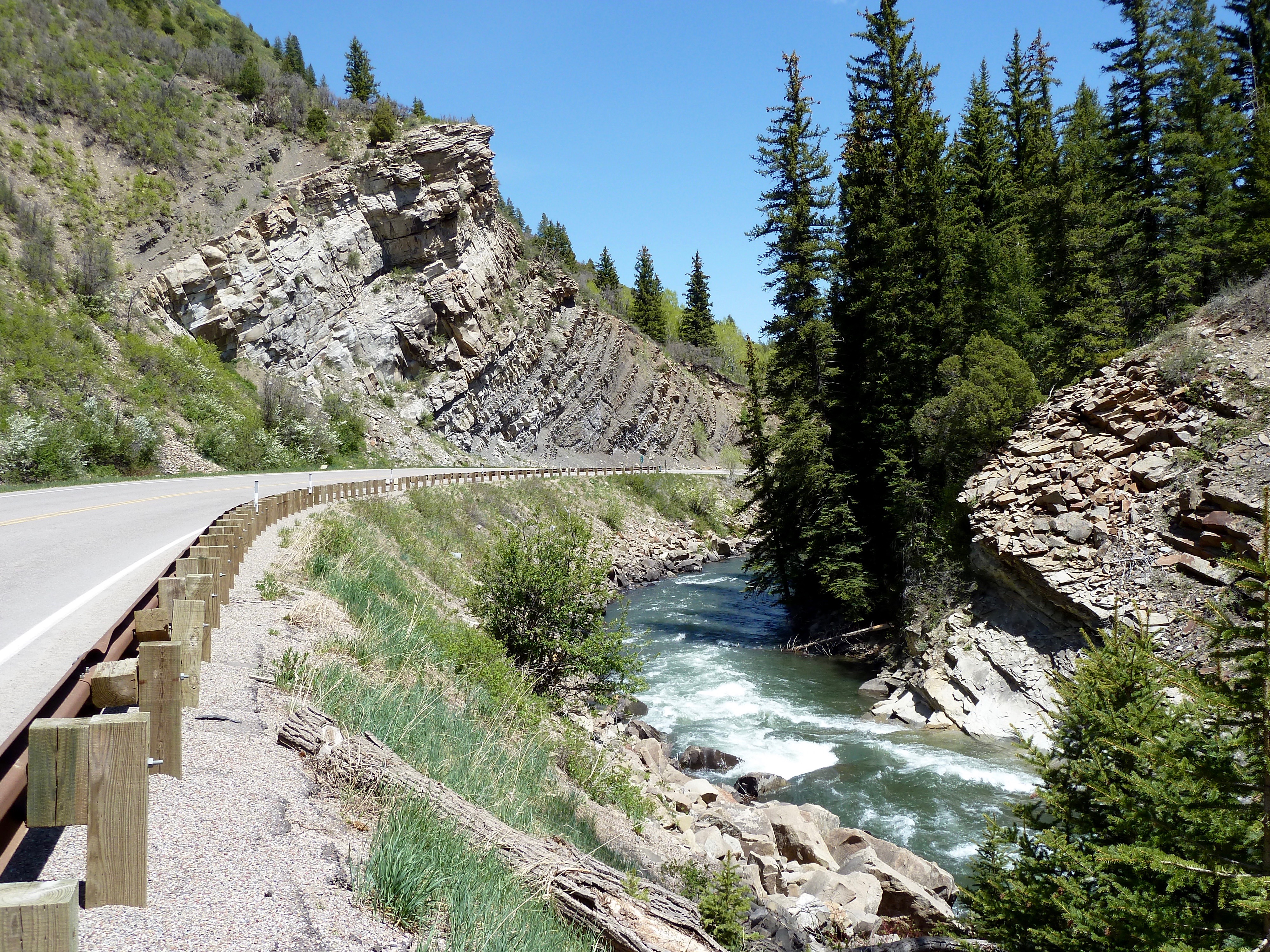
2018 story list: Aspen’s labor force
Dec. 21, 2018
Working in the shadows: Aspen’s long reliance on undocumented workers showing signs of stress
By Ali Margo

2018 story list: Aspen history
In 2018, local freelance writer and history investigator Tim Cooney wrote an in-depth story on a deadly 1984 avalanche in Highland Bowl. The story was published in collaboration with the Aspen Daily News and republished by The Avalanche Review.
March 31, 2018
Taming the snow beast
By Tim Cooney
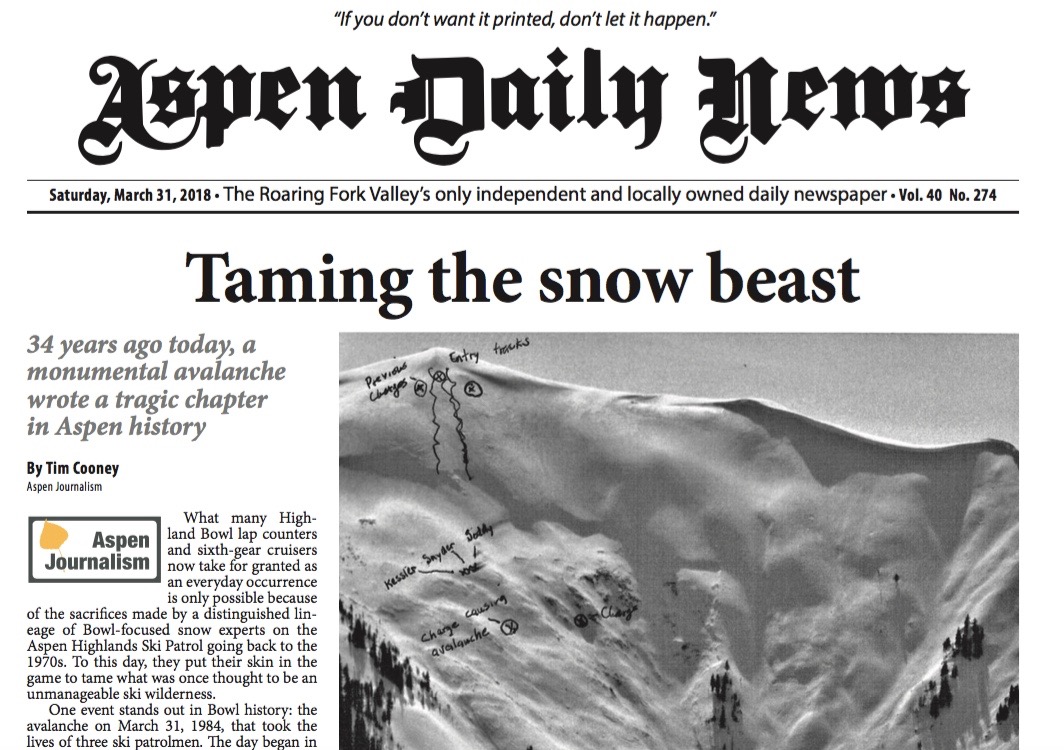
Reach
Our primary exposure to readers came through our ongoing, informal, newsroom-to-newsroom collaboration with newspapers owned by Swift Communications: The Aspen Times, the Glenwood Springs Post Independent, the Vail Daily, the Summit Daily, the Steamboat Pilot and the Greeley Tribune.
We also reached the readers of the Aspen Daily News, Aspen Sojourner magazine, The Colorado Sun, which launched in 2018, and Coyote Gulch.
We also reached our own audience on our website and Twitter feed.
Aspen Journalism’s digital channels
Aspen Journalism’s website: According to Google Analytics, from Jan. 1, 2018 to Dec. 31, 2018, the Aspen Journalism website site saw 62,811 sessions (down from 68,710 sessions in 2017), 50,698 users (down from 58,141 users in 2017) and 78,396 page views (down from 85,234 in 2017).
The AJ site had 216 active one-day users (up from 163 in 2017), 1,108 active seven-day users (up from 1,086 in 2017), 2,042 active 14-day users (up from 1,912 in 2017) and 3,967 active 30-day users (up from 3,946 in 2017).
We consider that this data suggests that we reach about 200 people daily on our website.
Aspen Journalism’s Twitter feed: 1,201 followers (up from 1,135 in 2017 and up from 1,047 in 2016).
Our reach via collaboration with newspapers and websites
Aspen Journalism stories in 2018 were featured in the following publications, and the estimated audience information comes from their websites.
To reach the potential audience figures, we’ve multiplied the daily print circulation of a publication by the number of stories we published with the organization. Hence, 46 stories in The Aspen Times multiplied by 9,000 copies = 414,000 in potential audience. We recognize, and emphasize, that 414,000 is the high-end potential audience for our stories.
The Aspen Times, distributed from Aspen to Carbondale with a daily print circulation of 9,000, and an online readership of 370,000 visits a month, or approximately 12,000 a day. We published 46 stories in 2018 with The Aspen Times, reaching a total potential audience of 414,000 print readers and 552,000 digital readers.
The Glenwood Springs Post Independent, distributed from Basalt to Rifle, with a daily print circulation of 9,000 and 30-day website traffic averaging more than 800,000 page views, or 27,000 per day, on average, according to the Post Independent. We published 20 stories with the Post Independent, reaching a total potential audience of 180,000 print readers.
The Vail Daily, distributed from Vail to Eagle, with a daily print circulation of 15,000. We published eight stories with the Vail Daily, for a total potential audience of 165,000 print readers.
The Summit Daily, distributed from Silverthorne to Copper Mountain, with a daily print circulation of 10,000. We published eight stories with the Summit Daily, for a total potential audience of 80,000 print readers.
The Steamboat Pilot, distributed in Routt County, with a daily print circulation of 9,000 and an online readership of about 12,000 “sessions” a day. We published one story in 2018 in the Steamboat Pilot, reaching a total potential audience of 9,000 print readers and up to 12,000 digital readers.
The Greeley Tribune is distributed in Weld County and the paper says that “81% of the 130,000 population reads the Greeley Tribune at least once a week.” We published three stories in 2018 in the Greeley Tribune.
The Aspen Daily News, distributed from Aspen to Glenwood Springs, with a daily print circulation of 14,500 and online readership of 5,000 unique visits a day, according to the Daily News. We published one history story in 2018 in the Daily News, reaching a total potential audience of 14,500 print readers and up to 5,000 digital readers.
The Colorado Sun is a new online-news publication, and we collaborated on one story with The Sun in 2018.
Aspen Sojourner is a glossy magazine published several times a year, serving the Aspen visitor and community markets. It has an estimated circulation of 18,000 per issue.
Coyote Gulch reaches approximately 5,000 visitors a day, mainly water professionals, including attorneys, engineers, and consultants. 59 of the stories we published in 2018 were also published on Coyote Gulch.
Radio exposure
Aspen Journalism reporters discussed water issues during four interviews on KDNK Carbondale Community Access Radio.
May 4, 2018
News brief: Lake Powell at 52% and dropping
July 12, 2018
City of Aspen’s plans to store water: Full interview with Brent Gardner-Smith
Sep. 14, 2018
News brief: Water officials step up “demand management” efforts
Nov. 23, 2018
News brief: Brent Gardner-Smith on water rights for Glenwood Springs whitewater parks

Impact
As in 2017, perhaps our most direct impact in 2018 was our ongoing reporting about the city of Aspen’s decisions regarding the conditional water-storage rights that it holds on upper Castle and Maroon creeks.
Aspen Journalism broke the story in 2012 and has followed it to this point, where the city has told the state of Colorado it intends to move its storage rights out of the two valleys.
The impact that Aspen Journalism’s reporting has had on the city’s decision to try to move the water rights was acknowledged with increasing frequency in 2018.
For example, at a July 30 retreat of the Aspen City Council, Mayor Steve Skadron said this about the city’s decisions to move the water rights: “It only happened because Brent, to his credit, did this remarkable investigative reporting.”
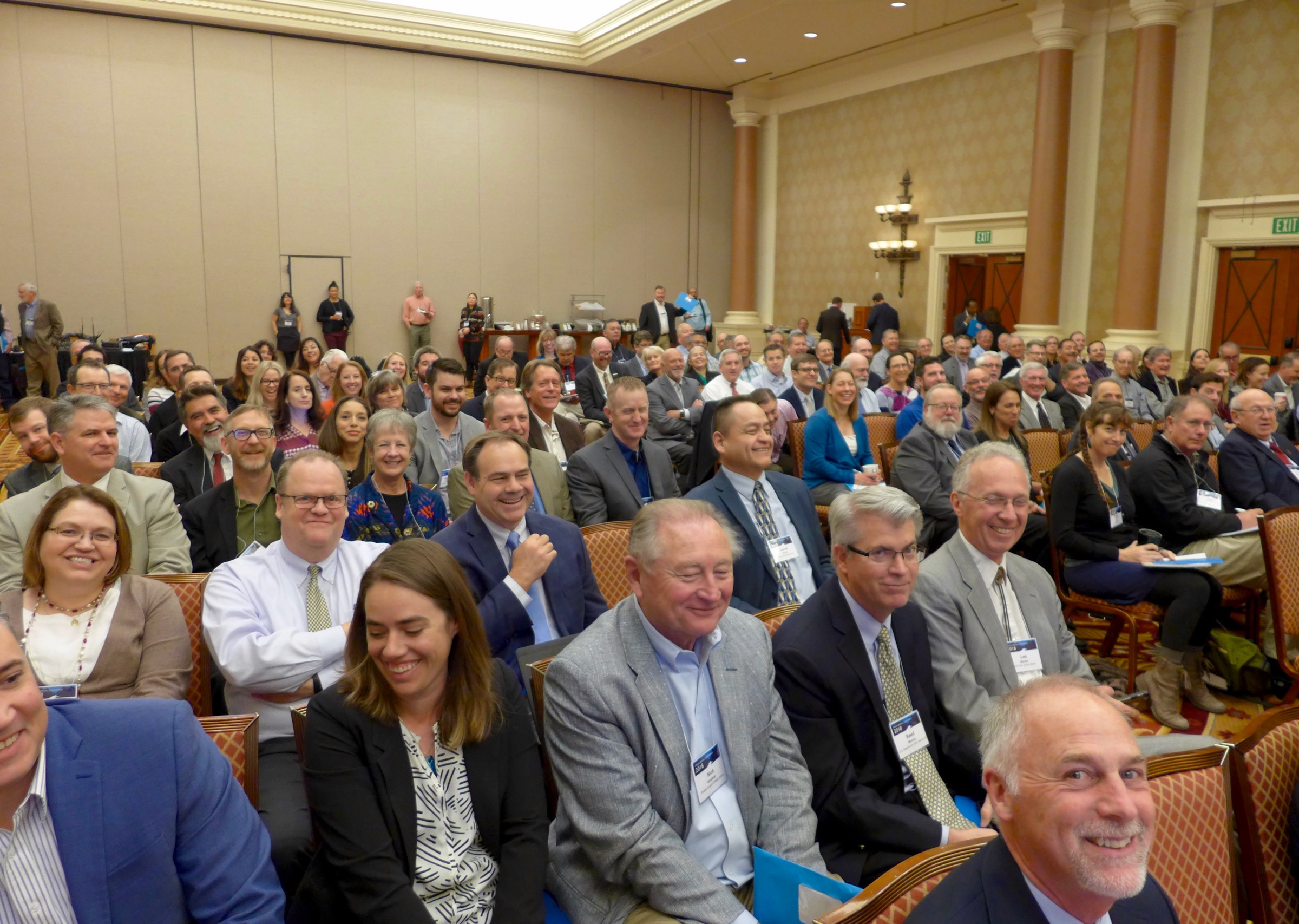
Unsolicited feedback
This letter-to-the-editor letter from Bill Jochems of Redstone was published in The Aspen Times on Dec. 23, 2018, with the headline “Important work by Aspen Journalism affects us all.” Jochems serves on the Pitkin County Healthy Rivers and Streams Board.
“My thanks to The Aspen Times for its collaboration with Aspen Journalism.
“Brent Gardner-Smith, the founder, editor and head of the water desk at Aspen Journalism, is so well informed on water matters that readers of his articles can learn the facts about water rights and issues in the Roaring Fork Valley, and the rights that divert water from our valley east through the divide and call water from our valley downstream in the Colorado River.
“Now is a time of deep concern that in the very near future there will be less water with which to feed and serve more and more people, and still sustain our natural environment. Gardner-Smith’s clear and understandable articles will help us comprehend these changes, and the adjustments we will be required to make.
“Also, thanks to the donors to Aspen Journalism’s nonprofit organization for keeping this valuable resource available.”
Other unsolicited feedback in 2018
“Brent Gardner-Smith has been doing a nice job of covering this for Aspen Journalism,” said author, professor and former water reporter John Fleck in an Oct. 21, 2018, blog post titled “Colorado’s east-west water divide poses risks for completion of a Colorado River Drought Contingency Plan.”
“Great reporting from @AspenJournalism on #COwater, #COriver, #COdrought issues!” said a tweet by Eagle River Water on Sept. 20, 2018, in response to our story “Mandatory curtailment of water rights in Colorado raised as possibility.”
“As always, Brent gets it right,” Eric Kuhn, retired general manager of the Colorado River District, said in a tweet on Sept. 18, 2018, in response to our story “Colorado River district GM unveils manifesto on water-use reductions.”

Editorial independence policy
We subscribe to standards of editorial independence adopted by the Institute for Nonprofit News.
Aspen Journalism is an independent news organization and retains full authority over its editorial content.
We are aware of the pitfalls that can arise when a news organization accepts any form of revenue, either in the nonprofit model in the form of donations or in the commercial model in the form of advertising. As such, we diligently maintain a firewall between revenue and the newsroom.
Our news judgments are made independently and are not based on or influenced by donors.
Our organization accepts donations to support the coverage of particular beats or broad coverage areas, but our organization maintains editorial control of all of the resulting coverage.
We cede no right of review or influence of any of our editorial content.
We do not accept anonymous donations.
We disclose donations on our “About & Contact” page, and we list each donation by name, the date we received the donation and the donation amount, and we do so as soon as we receive the donation.
When we deem it necessary and appropriate, we disclose our donors and key stakeholders in our stories or in an editor’s note.
Acceptance of financial support does not constitute implied or actual endorsement of donors or their products, services, actions or opinions.
Donors in 2018
Judith Barnard and Michael Fain, 1.5.18, $500
Brent Gardner-Smith, 1.7.18, $250
Richard Fallin via Kaye Foundation, 1.17.18, $1,500
John Orr, 1.20.18, $5
Lynda and Stewart Resnick via Resnick Foundation, 1.30.18, $2,500
Brent Gardner-Smith, 2.7.18, $250
Walton Family Foundation, 2.16.18, $100,000
John Orr, 2.20.18, $5
Brent Gardner-Smith, 3.1.18, $30
“News Match” 3.6.18, $27,171
Democracy Fund;
John S. and James L. Knight Foundation;
John D. and Catherine T. MacArthur Foundation;
Ethics and Excellence in Journalism Foundation; and
the Fund for Nonprofit News at The Miami Foundation
Brent Gardner-Smith, 3.7.18, $250
John Orr, 3.20.18, $5
Brent Gardner-Smith, 4.7.18, $250
John Orr, 4.20.18, $5
Ken Ransford, 4.27.18, $1,700
Brent Gardner-Smith, 5.7.18, $250
John Orr, 5.20.18, $5
Brent Gardner-Smith, 6.7.18, $250
John Orr, 6.20.18, $5
Brent Gardner-Smith, 7.7.18, $250
Amory Lovins, 7.20.18, $150
John Orr, 7.20, 18, $5
Maggie and Nick DeWolf Foundation, 8.7.18, $1,000
Brent Gardner-Smith, 8.7.18, $250
Brent Gardner-Smith, 8.13.18, $50
John Orr, 8.20.18, $5
Brent Gardner-Smith, 9.7.18, $250
Mark Harvey, 9.11.18, $1,000
John Orr, 9.20.18, $5
Heather Sackett, 9.27.18, $25
Dave Reed, 10.1.18, $25
Hensley and James Peterson, 10.5.18, $250
Brent Gardner-Smith, 10.7.18, $250
William Jochems, 10.10.18, $100
John Orr, 10.20.18, $5
Tim Cooney, 10.30.18, $30
Melony and Adam Lewis, via Aspen Community Foundation, 10.31.18, $10,000
Brent Gardner-Smith, 10.31.18, $200
Mary Conover, 11.1.18, $500
George Sibley, 11.1.18, $25
Catherine Lutz, 11.1.18, $25
Mary Dominick and Sven Coomer, 11.6.18, $100
Skip Berhost, 11.6.18, $500
Brent Gardner-Smith, 11.7.18, $250
Bill Spence and Sue Edelstein, 11.8.18, $1,000
John Keleher, 11.8.18, $25
Jim Pokrandt, 11.10.18, $100
Hilary Burgess, 11.10.18, $50
John Orr, 11.10.18, $5
Sara Ransford, via Arches Foundation, 11.12.18, $750
John Orr, 11.20.18, $5
Tim McFlynn, 11.20.18, $100
Brent Gardner-Smith, 11.20.18, $100
John McBride, via ABC Foundation, 11.23.18, $7,000
Loretta Lohman, 11.23.18, $25
Linda and Stewart Resnick, via Resnick Foundation, 11.26.18, $5,000
Buck Blessing, 11.27.18, $100
Austin Gardner-Smith, 11.27.18, $240 ($20 per month)
Antonia Zurcher, 11.27.18, $50
Curtis Wackerle, 11.27.18, $40
Simon Pinniger, 11.27.18, $500
Claudia Potamkin, 11.27.18, $100
Bill Hegberg, 11.27.18, $100
Howie Mallory, 11.28.18, $100
Joel Scott, 11.29.18, $100
Virginia Newton, 11.30.18, $50
Curtis Robinson, 12.1.18, $1,000
Michal Brimm, via Ernst and Wilma Martens Foundation, 12.1.18, $2,000
Tom and Cathy Crum, 12.1.18, $100
Will Roush, 12.1.18, $100
Sam Cox, 12.1.18, $75
Pam Moore, 12.1.18, $144
Alana Spiwak and Sam Stolbun, 12.3.18, $2,000
Paul Menter, 12.3.18, $200
Sara Garton, 12.3.18, $50
Greg Poschman, 12.3.18, $100
Robin Waters, 12.3.18, $25
Paul D’Amato and Beth Cashdan, 12.4.18, $50
Randy Gold and Dawn Shephard, 12.4.18, $50
John and Jacolyn Bucksbaum, 12.5.18, $1,000
Ann Harvey, 12.5.18, $500
Craig Corona, 12.5.18, $25
Molly Brooks, 12.6.18, $1,000
Ken Ransford, 12.6.18, $100
Linda Palevsky, 12.6.18, $100
Amory and Judy Lovins, 12.6.18, $150
Brent Gardner-Smith, 12.7.18, $250
George Stranahan, 12.7.18, $1,000
Patti Stranahan, 12.7.18, $1,000
Andy Wiessner, 12.7.18, $100
Russ Criswell, 12.7.18, $50
Stan and Toni Bialek, 12.9.18, $100
Marci and Robert Musser, via Aspen Community Foundation, 12.10.18, $1,000
John Orr, 12.10.18, $5
Robert Gardner, 12.11.18, $100
Paulina Vander Noordaa, 12.11.18, $25
Peter Looram, 12.11.18, $1,500
Mary and Hugh Wise, 12.12.18, $500
Ann Harvey, 12.12.18, $500
Thomas Harvey, 12.12.18, $1,000
Mark Harvey, 12.13.18, $10,000
Tommy Latousek, 12.14.18, $100
Laurie Loeb, 12.16.18, $50
Michael McVoy, 12.17.18, $1,000
Jon Fox-Rubin, 12.17.18, $35
Barbara Reese, via Stargazer Advised Fund at Aspen Community Foundation, 12.17.18, $1,000
John McBride, Jr. via ABC Fnd., 12.18.19, $1,000
Anne Rickenbaugh, 12.18.18, $100
Pete McBride via ABC Fnd., 12.18.18, $1,000
Dave Danforth, 12.19.18, $500
Judith Steinberg and Paul Hoenmans, 12.19.18, $1,000
Jon Banks, 12.19.18, $250
Bob Purvis, 12.19.18, $500
Mark Tache and Christin Cooper, 12.19.18, $100
Karin Teague, 12.19.18, $50
Bob Harris, 12.19.18, $100
Jimmy Ibbotson, 12.20.18, $1,000
Michael Hassig and Olivia Emery, 12.20.18, $100
Michael Kinsley, 12.20.18, $70
Carol Craig, 12.20.18, $1,975
Rick Lofaro, 12.20.18, $25
Steve Smith, 12.20.18, $50
Sue Cross, 12.20.18, $10
Marianne Kipper, 12.20.18, $100
Aron Ralston, 12.21.18, $100
Hawk Greenway, 12.24.18, $50
Ruth and Bob Wade, 12.24.18, $50
Kevin Ward, 12.25.18, $100
Frank Peters and Marjory Musgrave, 12.27.18, $500
Susan Pew, 12.27.18, $1,000
Rob Pew, 12.27.18, $1,000
Judith Barnard and Michael Fain, 12.28.18, $500
John Katzenberger and Deb Jones, 12.28.18, $75
Patty Lecht, 12.28.18, $10
Lisa Tasker, 12.28.18, $25
Madeleine Osberger, 12.31.18, $50
Bill Stirling, 12.31.18, $50
Rhett Armstrong, 12.31.18, $75
Caroline Bradford, 12.31.18, $100
Brian Keheler, 12.31.18, $25
Michael Lipkin, 12.31.18, $300
Barbara Reid and David Hyman, 12.31.18, $250
Diane Johnson, 12.31.18, $50
Timothy Gorman, 12.31.18, $250

Journalism Advisory Board
Dave Danforth
Dave is the former owner of the Aspen Daily Newsand remains a columnist at the paper.
Charles Davis
Charles is dean of the Grady College of Journalism and Mass Communication at the University of Georgia and is the co-author of “Principles of American Journalism.”
Charlie Firestone
Charlie is the executive director of the Aspen Institute Communications and Society Program and previously was director of the communications law program at UCLA.
Laura Frank
Laura is the chief content officer at Rocky Mountain PBS in Denver and a former investigative reporter at the Rocky Mountain News.
John Masters
John is the executive director GrassRoots Community Network.
Mike McPhee
Mike is an author and a former reporter at The Denver Post, where he shared in a Pulitzer Prize in 2000.
Rem Rieder
Rem served as an editor-at-large and the media columnist at USA Today and previously was the editor of American Journalism Review.
Curtis Robinson
Curtis is the co-founder of Roaring Fork Sunday and a former editor of the Aspen Daily News. He remains at-large.
Carolyn Sackariason
Carolyn is a reporter at The Aspen Times. She has also served as news director at Aspen Public Radio and editor at the Aspen Daily News and the Snowmass Sun.
Steve Skinner
Steve is a columnist at the Aspen Daily News, served as general manager at KDNK and is now guiding KFFR, a public-radio station in Grand County.
Andy Stone
Andy is the former editor of The Aspen Times, where he also wrote a column for years. He’s the author of “Aspen Drift.”
Mike Webb
Mike is a vice president at the public-relations firm BerlinRosen. Previously, he was the sales and marketing director at Civil Beat and the vice president of communications at ProPublica.

Professional Support
Denise Jurgens
Denise, a CPA and partner at Reese Henry & Company, has deep expertise in auditing and accounting services. Denise has overseen preparation of Aspen Journalism’s annual tax filings since 2011.
Mike Marolt
Mike is a CPA and a KPMG Peat Marwick alumni.
Ken Ransford
Ken is an attorney, investment adviser and CPA who specializes in income-tax and estate-tax law for small businesses, individuals and nonprofit organizations. Ken prepared and filed Aspen Journalism’s application in 2011 to obtain 501c3 status for Aspen Journalism.

Board of Directors
Mark Harvey, Treasurer
Mark is a rancher, writer, filmmaker and photographer. He is the author of “The NOLS Wilderness Guide” and the producer and director of the documentary “A Land Out of Time.” Mark is the current president of the board of EcoFlight and has served on the boards of High Country News, Aspen Center for Environmental Studies, and Public Counsel of the Rockies.
Tim McFlynn, Chair
Tim is the executive director of Public Counsel of the Rockies and a professional mediator with Aspen Dispute Resolution. He was co-founder and longtime trustee of Pitkin County Open Space and Trails and co-founder and director of the Manaus Fund. He has served as board president of Aspen Center for Environmental Studies, Wilderness Workshop, Western Resource Advocates and other conservation and advocacy organizations.
Michael McVoy
Michael is an Aspen-based investment adviser, the former co-publisher of The Aspen Times and a Manaus Fund board member.
Harry Teague
Harry is the founder and principal designer at Harry Teague Architects. He has lived in the Aspen area since 1972, when he received his master’s degree in architecture from the Yale School of Architecture. Teague’s work, which includes the Benedict Music Tent in Aspen, has been widely recognized and appreciated.

About Aspen Journalism
Aspen Journalism is an independent journalism organization founded in 2011 and based in Aspen, Colorado. We are a 501c3 nonprofit corporation and considered an educational organization by the Internal Revenue Service.
Our mission is to produce quality, in-depth journalism, as we believe well-informed citizens make better decisions. Our approach is both investigative and collaborative.
Our coverage area radiates outward from Aspen to Snowmass Village, Pitkin, Eagle, Garfield and Summit counties, the Western Slope, Colorado, and the West.
Since 2011, we’ve covered water, education, land-use, local government, housing, transportation, energy, wealth, real estate, the ski industry and development.
Aspen Journalism is a recognized member of the Colorado Press Association and the Institute for Nonprofit News.
Our office is in the Benedict Building in Aspen, at 1280 Ute Avenue, Suite 4.
We welcome comments, suggestions and questions via phone (970-948-1930) and email (news@aspenjournalism.org).
Our mailing and office address is:
Aspen Journalism
1280 Ute Avenue, Suite 4
Aspen, CO 81611

